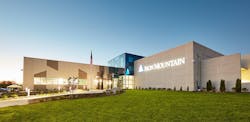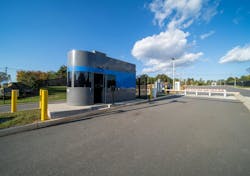Data Center Tours: Iron Mountain VA-1, Manassas, Virginia
During a recent visit to Iron Mountain's VA-1 data center in Manassas, Virginia, Data Center Frontier had the opportunity to explore the facility and discuss its features with Rohit Kinra, Senior Vice President and General Manager of Hyperscale Data Centers at Iron Mountain.
The tour provided insights into the company's commitment to security, customer service, and its strategic growth in the data center industry.
In-House Security Highlights Diverse Facility Offerings
As we entered the lobby of VA-1, Kinra emphasized Iron Mountain's distinctive approach to security. "One thing that differentiates us is that we in-house our security people. They're Iron Mountain employees," he explained. "We think that's important because that's usually our customers' very first interaction when they come to one of our facilities."
This strategy fosters a cohesive team environment, as security personnel collaborate closely with operations staff to meet customer needs, including tasks like receiving packages. Kinra noted, "We think it makes a difference. We've seen that in our Net Promoter Scores when we do customer relationship surveys."
When discussing workforce dynamics, Kinra acknowledged the industry's challenges in attracting and retaining skilled personnel. "We think that they're part of the team," he said, referring to their in-house security and operations staff. This integrated approach not only enhances security but also contributes to a positive workplace culture, which is crucial in an industry facing talent shortages.
Strategic Expansion in Virginia Reflects Commitment to Customer Support
Iron Mountain's Manassas campus showcases a blend of single-tenant and multi-tenant buildings, catering to a wide range of clients. "We have a mixture on the campus," Kinra said. "This is actually a really great multi-tenant building. We have a wide variety of customers in the building." This diversity allows Iron Mountain to accommodate various customer requirements, from cloud services to colocation needs.
Iron Mountain has been actively expanding its presence in Virginia to meet growing demand. In November 2024, the company acquired a 66-acre development site in Richmond, aiming to establish a new data center campus with over 200 megawatts of expected capacity. Additionally, a new 40-acre site in Manassas was secured to add two new data center buildings, offering an estimated 150 megawatts of additional capacity.
Inside the VA-1 facility, the dedication to customer support is evident. "On the right is where we have our smart hands folks," Kinra pointed out. "These are the techs that support the data center, support all our customers. If our customers need us to do something for them, they submit a ticket through our portal. Our techs are here, and then they'll go do the work that the customers want them [to do]." This hands-on approach ensures that client needs are promptly addressed by knowledgeable staff.
Iron Mountain Northern Virginia Overview
Iron Mountain's Northern Virginia data centers VA-1 through VA-7 are situated on a 142-acre highly secure campus in Prince William County, Virginia.
Located at 11680 Hayden Road in Manassas, Iron Mountain VA-1 spans 167,958 sq. ft. and harbors 12.4 MW of total capacity to meet colocation needs. The 36 MW VA-2 facility stands nearby.
The total campus features a mixture of single and multi-tenant facilities which together provide more than 2,000,000 SF of highly efficient green colocation space for enterprises, federal agencies, service providers and hyperscale clouds.
The company notes that its Manassas campus offers tax savings compared to Ashburn and exceptional levels of energy-efficiency as well as a diverse and accessible ecosystem of cloud, network and other service providers.
Iron Mountain's Virginia campus has 9 total planned data centers, with 5 operational facilities to date and two more data centers coming soon. VA-2 recently became the first data center in the United States to achieve DCOS Maturity Level 3.
As we continued the tour, Kinra led the way toward the break room, an area where customers can grab coffee or catch up on work. Unlike the high-end aesthetic of some other colocation providers, Iron Mountain's approach is more practical and focused on functionality.
At the secure shipping and receiving area, Kinra explained the process for handling customer equipment.
"This is where our customers ship their equipment into," he said. "They submit a ticket, send their shipments in, and we'll take it, put it aside for them, and let them know when it's here. Sometimes they ask us to take it to their environment, which we'll do for them via a smart hands ticket."
Power Infrastructure and Security Measures
The VA-1 campus is supported by a single substation, providing the necessary power for its growing infrastructure. While a visit to the generator yard wasn’t possible, Kinra pointed out the facility's backup generators, emphasizing Iron Mountain's commitment to reliability. "We provide space, power, cooling, and part of that is making sure that it's available 100% of the time. So we're backed up by generators on the facility. These are your standard diesel generators."
To enhance security and accessibility, Iron Mountain has implemented live video feeds for key infrastructure areas. It makes for fairly sedate viewing. "I will tell you - someone's asked me before - -t's a live feed. I can go up there and wave if you'd like," Kinra joked. He added, "This way we can give the tour and show the equipment without putting you in the environment."
Similarly, Iron Mountain uses video monitoring for the facility’s CRAH [computer room air handling] galleries, providing a transparent view of electrical and mechanical infrastructure. "For safety and security, we obviously can't take visitors inside, but this way we can actually give them a view of it," Kinra explained.
Network Connectivity and Carrier Diversity
As a core part of the Virginia campus, VA-1 serves as the connectivity hub for the site. "We have two network rooms in this building—Network A and Network B," Kinra said. "Super highly diverse in terms of carriers in this building. And this building is the hub for the campus." Most major carriers enter through VA1, allowing seamless connectivity across the campus.
Kinra pointed to a fiber map displaying the interconnections between VA1, VA2, VA3, and beyond. "As you were coming in across the street, you might have seen VA6," he noted. "And then this will show you the fiber path, the fiber maps through the buildings. We have a good amount of carriers on the campus that support our customers’ needs. If they want other carriers, we work with them and the carrier to get them into the meet-me room."
Iron Mountain also offers dedicated storage and office spaces within VA-1 for customers, providing a comprehensive suite of services beyond colocation.
AI and Data Center Usage: A Growing Conversation
Kinra highlighted the increasing focus on AI in data center discussions. "A lot of customers these days are asking about AI. Is it all we talk about? Maybe not, but it's certainly a major topic of conversation. Many customers are trying to figure it out for themselves and determine how they can meet their needs from a data center perspective."
He noted that clients are making progress in their AI adoption but are still navigating their needs. "I can’t speak to exactly what they’re doing with their technology, but in terms of whether they are finding what they need in the data center, the short answer is yes."
A significant indicator of this shift is rising power densities in data centers. "Even in these three buildings you’re seeing here, the densities have gone up. This building averages about eight and a half kilowatts per rack, while VA3 is at 42 to 44 kilowatts per rack. They’re using a lot of power in that building."
Security, Infrastructure, and Innovation
Kinra also pointed out the unique modifications customers implement for security and efficiency. "One of our customers clearly doesn’t want anyone seeing into their space. This is the type of thing I find interesting because it’s all unique. The reason I brought you into this data hall was to show the variety of use cases and different solutions customers have implemented."
The company has also been investing in energy technologies and backup power solutions. "For battery backup, we use a mix of both lithium-ion and lead-acid. This building has lead-acid, while the BA2 building has lithium-ion."
Regarding alternative energy sources, Kinra emphasized the company’s commitment to exploring sustainable solutions. "We have an innovations team that evaluates all of these areas. For example, they look at liquid cooling—what should the design be? What should our reference design be? They’re exploring alternative energy sources and different types of fuel for generators, such as HVO. In Europe, we already use HVO."
The Growth of Manassas and Beyond
On the topic of regional expansion, Kinra explained the significance of Manassas in the data center industry. "We were one of the first companies to establish a presence in Prince William County, in Manassas. Since then, the area has grown tremendously."
Kinra notes how, as development spreads beyond traditional hubs, firms are expanding their definitions of the market. "One of the analyst firms ... used to refer specifically to Northern Virginia, but now they classify the entire state because data centers are being built everywhere, from Louisa County to north of Richmond and even Culpeper County."
Conclusion
With its strong focus on security, reliability, and customer service, Iron Mountain continues to solidify its presence as a leading data center provider in Virginia. By investing in expansion, connectivity, and operational excellence, the company is well-positioned to support the evolving needs of hyperscale and enterprise customers alike.
About the Author
Matt Vincent
A B2B technology journalist and editor with more than two decades of experience, Matt Vincent is Editor in Chief of Data Center Frontier.






